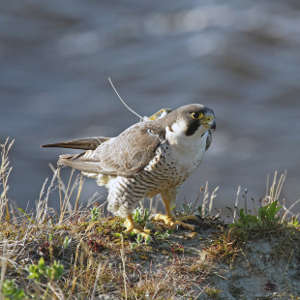Using AI to control energy for indoor agriculture
30 September 2024
Published online 5 March 2021
Climate has had a historical impact on falcon migration routes, while genetic factors influence migratory distances.

Andrew Dixon
Now, a study conducted by researchers in China, the United Kingdom, Russia, Germany and the United Arab Emirates suggests that migratory routes used by peregrine falcons that breed in Arctic Eurasia have been shaped by environmental changes since the Last Glacial Maximum, the most recent period in Earth history when ice sheets reached their maximum worldwide, around 20,000 to 30,000 years ago.
The team examined satellite-tracking data from 56 peregrine falcons from six Eurasian Arctic populations. They also looked at genomic data from 35 peregrines from four of these populations.
They found that the birds used five distinct migration routes across Eurasia. Using present-day and palaeoclimate datasets, the team reconstructed and compared the sizes of breeding and wintering areas that would have been available to the birds over a timescale of millennia. The gradual divergence of the routes, they say, can be explained by northward contractions and latitudinal shifts in the birds’ breeding grounds during the transition from the Last Glacial Maximum to the Holocene Epoch, which continues through to today.
The findings also revealed that the gene ADCY8 is implicated in differences in migratory distance. Peregrines that migrated over longer distances had a dominant genotype of ADCY8, which the researchers infer may be linked to an increased capacity for long-term memory.
In view of growing evidence that global warming is already appearing to have a detrimental impact on Arctic bird populations, the researchers used modelling simulations to project future scenarios for the peregrines’ breeding and wintering ranges. “Our simulations predict that future global warming might lead to a change in migration strategies and diminish the breeding ranges of peregrine populations of the Eurasian Arctic,” says corresponding author Xiangjiang Zhan of the Institute of Zoology at the Chinese Academy of Sciences. Peregrines in western Eurasia are most at risk of population decline. They may stop migrating altogether and be driven towards extinction, as they may lose most of their suitable breeding habitats by 2070, the study suggests.
Overall the findings lay a cornerstone for peregrine conservation, Zhan says. International collaboration will be key for furthering conservation efforts that take account of ecological interactions and evolutionary processes.
doi:10.1038/nmiddleeast.2021.23
Gu, Z. et al. Climate-driven flyway changes and memory-based long-distance migration. Nature https://doi.org/10.1038/s41586-021-03265-0 (2021).
Stay connected: